In this collection, we have twelve of the strangest and most remarkable churches on the planet. Listed here are some of the world’s oldest and most revered religious buildings. These cathedrals have played a pivotal role in developing architectural history and ideas by their magnificent exteriors and world-class interiors.
Learn more about these essential components of the world’s cultural heritage and take a closer look at these cathedrals. However, religious structures such as churches, monasteries, and other religious facilities are among the most magnificent architectural feats on the face of the planet.
The cathedrals and churches in this list include well-known landmarks and those you may not have heard of before. Consider the churches on this list and take your time with it.
1. The Green Church (Buenos Aires, Argentina)

More than 50 years ago, the phrase “green architecture” was coined, indicating that humans were beginning to consider the influence of their actions on animals and the environment. During the twenty-first century’s first decade, vertical gardens, green terraces, and hanging greenhouses became increasingly popular in megacities.
It appears that the practice of beautifying facades with real flowers has been around for quite some time in several different states. The Church of Jesus in the Olive Garden in Argentina is widely regarded as the world’s first “green church,” according to its use of environmentally friendly practices.
This tranquil and distinctive aspect is achieved by wrapping it with ivy from the ground up. Is it any surprise that this is the location of choice for most weddings in Buenos Aires?
2. Paoay Church, a.k.a St. Augustine Parish (Philippines)
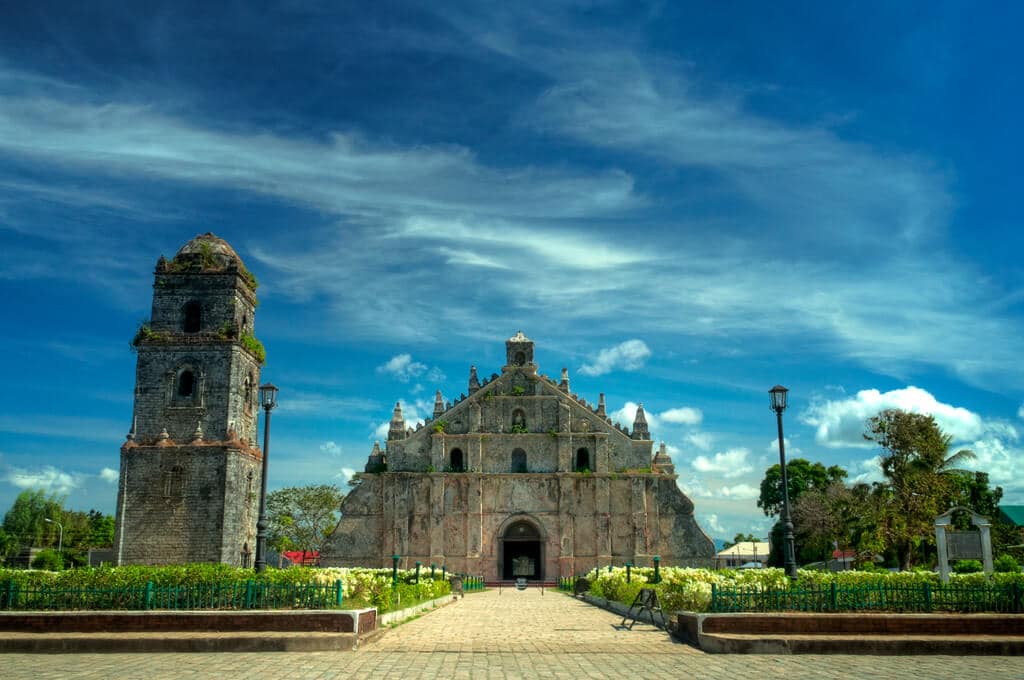
In the Philippines, the Paoay Church, or Saint Augustine Church, is a Roman Catholic church located in the municipality of Paoay. Built-in 1710, the Church is known for its distinctive architecture, accentuated by the massive buttresses that line the building’s sides and rear. In 1973, the Philippine government designated it as a National Cultural Treasure, and in 1993, it was included on the UNESCO World Heritage List as part of the Philippines’ Baroque Churches group.
In 1686, the Augustinian Parish of St. Augustine was established in the region, making it the oldest Augustinian Parish in the United States. Father Antonio Estavillo, an Augustinian friar, began building the current Church in 1694, and it was finished in 1710 and re-dedicated in 1896.
Former First Lady Imelda Marcos spearheaded restoration efforts after the Church suffered damage in the 1865 and 1885 quakes. An earthquake baroque architecture adapted to the country’s seismic conditions, as described by Alicia Coseteng for the Paoay church, is the Philippines’ most prominent example of this type of architecture.
The enormous buttresses on both sides and the back of the building help to stabilize the structure. With so many devastating earthquakes throughout the nation, the adaptive re-use of baroque architecture against earthquakes has evolved. Other examples of Javanese-inspired architecture may be seen in the Church’s walls and facade.
3. Pilgrimage Church (Neviges, Germany)

A pilgrimage church and Parish in Neviges, North Rhine-Westphalia, Germany, called Maria, Königin des Friedens (Mary, Queen of Peace). Cardinal Josef Frings of Cologne, influenced by the Second Vatican Council, was open to the idea of a completely new church structure.
The brutalist building designed by Gottfried Böhm was approved by Cardinal Schönborn. To this day, it remains the architect’s most iconic building, with its concrete construction and irregularly sloped roof, as well as its open-air interior that evokes a public forum. Thanks to its concrete roof, the Church has been connected with numerous objects, including tents, crystals, rocks, and a town. The low-ceilinged entrance hall is kept dark to highlight the altar, bathed in light from the Church’s many stained-glass windows.
The Second Vatican Council’s concepts are reflected in the interior design. In contrast to the elaborately decorated churches with the altar and congregation separation. The Gnadenkapelle, the Sacraments Kapelle, and the Unterkirche (the Lower Church) beneath the main hall are available for private prayer and devotion. The large windows, such as the green Schlangenfenster (Snake Window) and the red Rose Fenster (Rose Window), were also designed by Böhm, with the rose motif being a recurring one throughout the building.
Cologne sculptor Elmar Hillebrand designed the Mariensäule (Mary’s Column), the altar, and a high tabernacle housing the Eucharist. The first electronic organ was installed in the Church, but In May of 2010, a pipe organ was dedicated.
4. Grundtvig’s Church, (Copenhagen, Denmark)

In 1913, Peder Vilhelm Jensen-Klint won a competition to be named Grundtvig. In 1927, the Tower Church was inaugurated for the first time after completing the tower part in 1921-1926. When Klint’s father died in 1930, his son Kaare completed the interior and the nearby structures until 1940.
The Church is surrounded by a residential subdivision planned by Jensen-Klint to complement the Church (1924–36). Architect Jensen-Klint included a variety of architectural styles into the design for Grundtvig’s Church. His design was influenced by their building skills, materials, and ornamentation.
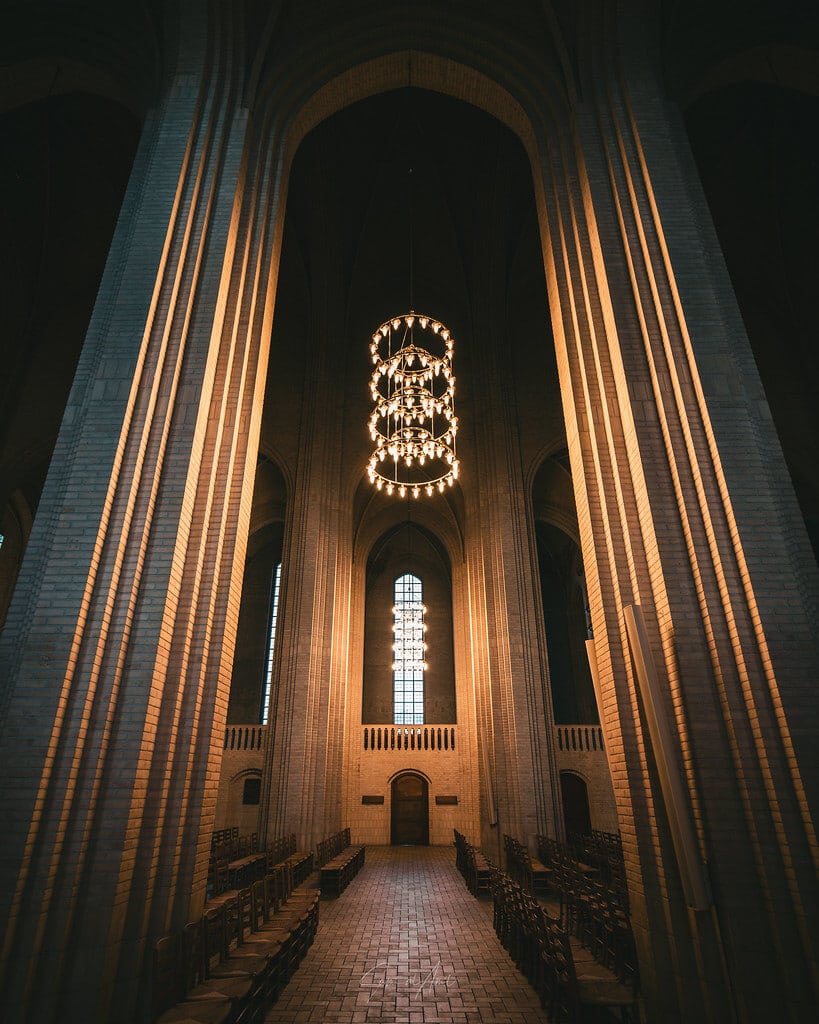
They combined brick Expressionism’s contemporary geometric shapes with Gothic architecture’s traditional verticals. The building’s west face, suggestive of a west-work or the outside of a church organ, is the most eye-catching aspect. The lower half of the tower is made of plain bricks, while the top half has the appearance of one continuous, rippling surface. It may accommodate a congregation of 1,440 people within the Gothic-inspired interior, which is on par in size with Copenhagen Cathedral.

The tower was constructed using five million yellow bricks, a common Danish building material. The interior layout mimics a conventional Gothic church, with a nave, two lateral aisles, and a short transept. Yellow brick and an absence of decoration, on the other hand, give the structure a Gothic feel while yet maintaining a simple modern design.
5. Colonia Catholic Church (Uruguay, South America)

The Catholic Church in Uruguay and the Society of Architects of Uruguay organized a nationwide competition to build a small church near Colonia, Uruguay, on the River Plate shore. Lambrechts-Bertinat Architects were the title holders of this competition. They finished the undertaking in time for the holiday season in 2006.
Isolated Parent Beach is home to a modest Catholic Church that stands on the banks of the River Plate. The stark contrast between the white sand and the crimson waters of the River Plate creates an ethereal glow that reflects in the Church’s colors. Visitors are drawn to the “floating above” hyper-paraboloid roof, held in place by two folding-bracing walls. The inside is bright and airy.
This solitary sculptured chapel is likewise sympathetic to the village’s traditional architecture. The cross/campanile is the only prominent feature visible from the beach, rising above the line of trees that flank the shore. According to legend, an Indigenous South American artist created an XVIIth century wooden carving of the Virgin Mary, which was carried to Europe by great South American rivers. The design was based on this inspiration.
Since the early 1920s, Modern Dutch Expressionism has been a standard architectural style in Uruguayan homes and public spaces. With its reflected features and reflective capabilities, the Church rises above the moat of water and performs masses in the outdoor areas during the summer.
6. The Felsenkirche a.k.a. Church of the Rock, (Idar-Oberstein, Germany)
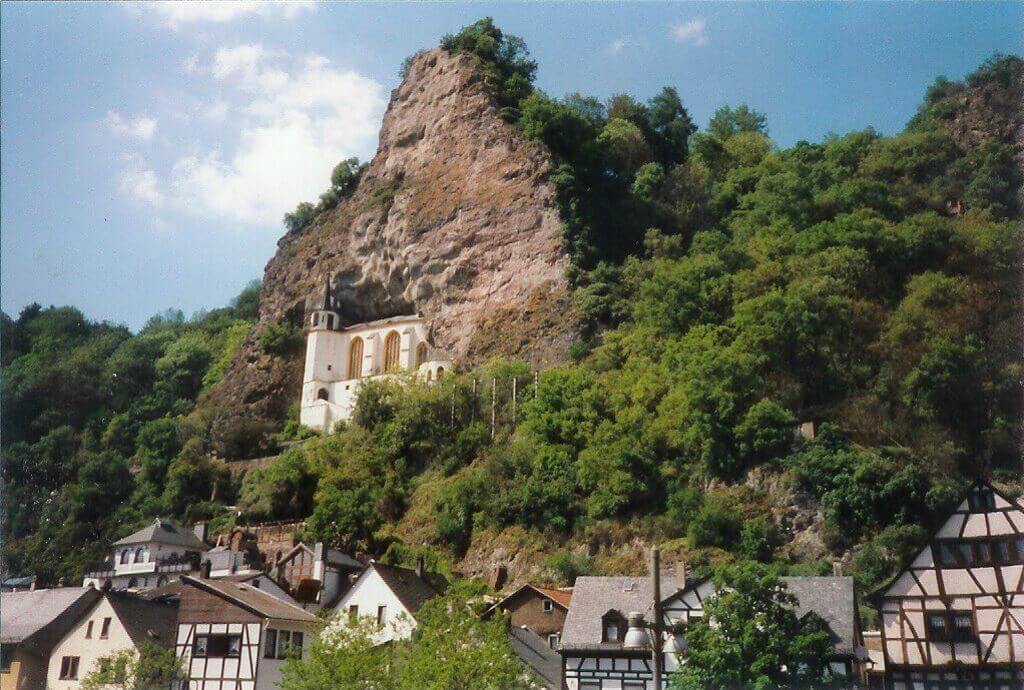
The Felsenkirche (also known as “Church-in-the-Rocks” and “Crag Church’ ‘), a unique cliffhanging chapel, was erected to atone for the death of a prince by his jealous brother, according to legend. Both Wyrich and Emich, the two brothers who resided in the castle on the cliff’s edge, were rumored to be madly in love with Bertha, a stunning woman. During Wyrich’s absence, he married the woman of his affections. The betrayed sibling threw his successful competitor from a castle window when he returned from exile in a fit of passion.
Remorseful of his brother’s death, Wyrich dug the Felsenkirche cavern 165 feet beneath the castle where his brother’s body had been discovered. In any case, the accusation is without foundation. A gurgling springs out of the cliff high above the village. A small yet powerful church was built in this cavern in 1484 on an earlier fortress or place of worship. This underground spring is presently gushing forth its natural waters throughout the structure.
A natural agate crucifix, a Gothic baptismal stone, and an antique organ from 1756 round out the collection. Worshippers at the Idar-Oberstein Felsenkirche must be among Germany’s fittest churchgoers, given the steep 230 stairs and short tunnel that separate the Church from the town below. The Felsenkirche can only be reached by climbing 230 steps and 165 feet from Idar-market.
7. Cathedral of Maringa (Parana, Brazil)
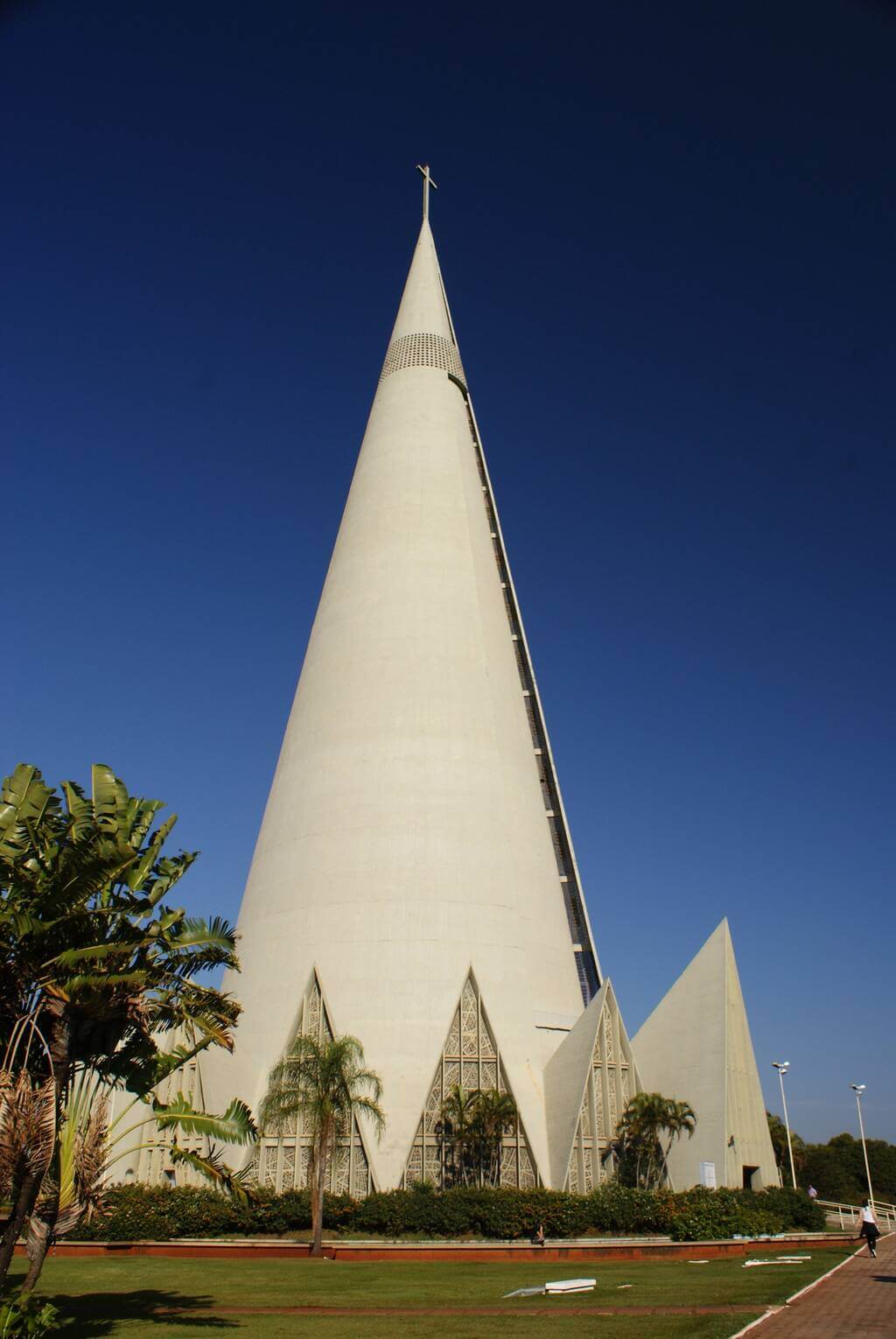
In Maringá, Parana, Brazil, the Cathedral of Maringa, the highest Church in South America and the 16th tallest Church globally, provides the impression that you’ve almost reached God up there. The 124-meter-tall Maringá Cathedral was built in 1972 and is the highest point in the city. It was 25 years ago when the city of Maringa opened its cathedral.
The Cathedral of Maringá, located in the city’s heart, is the city’s most prominent landmark. Expedito Sobreiro Ribeiro, one of Brazil’s best baroque sculptors, created the statue of “Our Lady of Glory” directly across the street from Maringá Cathedral. You must take a flight of 598 stairs covering 18 stories to join the Maringá Cathedral’s inner and outer cones. The cathedral’s 14th-floor observatory provides impressive views of the city.
Several prominent Maringa residents are buried in the cathedral, and you may view their inscriptions as you ascend the stairs. A priest by the name of Orivaldo Robles has authored a book called “A Igreja que brotou da mata” (“The church that sprang from the forest”), which chronicles the history of the city of Marina and the construction of the Cathedral of Maringá.
8. Salt Cathedral of Zipaquira (Cundinamarca, Colombia)

An underground Roman Catholic church has been created in a halite mountain in Zipaquirá, Colombia, some 660 feet (200 meters) below the earth’s surface. One of the country’s most popular tourist attractions and a pilgrimage center, The temple at the bottom depicts Jesus’ birth, life, and death in three distinct portions. They are all hand-carved into the halite rock. There are also several marble statues on display.

The cathedral has been dubbed a “Jewel of Modern Architecture” and is one of Colombia’s most famous architectural achievements. The cathedral is a priceless piece of cultural, environmental, and religious heritage for the Colombian people.
Although the cathedral functions as a church, it does not have a bishop and does not have a cathedral’s formal status in Catholicism.


9. Bruder Klaus Chapel (Mechernich, southern Germany)
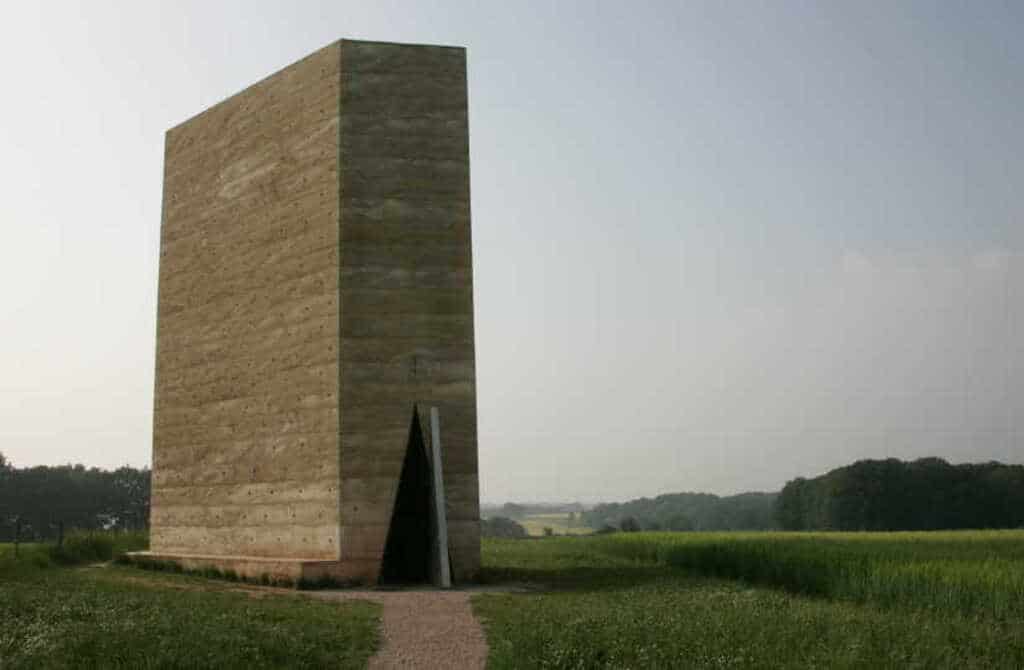
The Swiss architect Peter Zumthor designed the chapel, constructed between 2005 and 2007. In gratitude for a good and fulfilling life, the Trudel family and Hermann-Josef Scheidtweiler wanted to build a chapel on their land and consecrate it to the Swiss saint of peace, Nikolaus von Flüe (Brother Klaus), the patron saint of the Catholic Rural People’s Movement and the Christian Rural Youth Movement, which Hermann-Josef Scheidtweiler worked for many years in a responsible position on an honorary basis.
When Peter Zumthor was developing the Kolumba Diocesan art museum in Cologne, the Scheidtweiler family met him. On May 19, 2007, Cologne Auxiliary Bishop Heiner Koch, who is now Archbishop of Berlin, dedicated the chapel, and it has since drawn a large number of visitors.
The chapel was conceived and erected by Swiss architect Peter Zumthor between 2005 and 2007. The Landwirtsfamilie Trudel and Hermann-Josef Scheidtweiler, who wished to build a chapel on their own land “out of gratitude for a good and happy life,” invited Swiss Peace Healer Nikolaus von Flüe (Bruder Klaus), protector of the Catholic Landvolk and Catholic Landjugend movements, and long-time volunteer Hermann-Josef Scheidtweiler.
When Peter Zumthor built the diocesan art museum Kolumba in Köln, the Scheidtweiler family visited him. Heiner Koch, the current Erzbischof of Berlin, consecrated the chapel on May 19, 2007, and it has attracted a large number of visitors ever since.
10. Santuario Madonna della Lacrime (Sicily, Italy)

Madonna Delle Lacrime Basilica in Siracusa, Sicily, Italy, is a 20th-century Roman Catholic Marian shrine church. Approaching Ortigia, the contemporary skyscraper, which some have criticized as an inverted ice cream cone, dominates the landscape.
The design and building of the sanctuary were very contentious. The method may be supposed to evoke the impact of a massive teardrop on the Earth. It needed special authorization to build on top of an archeological site. It was also criticized for being overly ornate to commemorate a supposed miracle between August 29 and September 1, 1953, when a plaster Madonna of the Immaculate Heart image was said to have wept tears for an impoverished local couple, including the wife of a fisherman. Crowds were rumored to have gathered, and fluid samples were reportedly taken. Afterward, the symbol was relocated to this location via degli Orti.
In 1954, the first foundation stone was laid for the new building. The sanctuary was elevated to a minor basilica by Pope John Paul II in 2002. The Episcopal Conference of Sicily designated it a regional shelter in 2019.
Francesco Caldarella’s Madonna adorns the dome in rings and rays, gilded bronze. The four panels on the altar’s bronze foundation portray the Book of Revelation’s Apocalyptic visions. As St. Paul writes in the Epistle to the Ephesians, “Christ loved the Church and gave Himself up for her.”
11. The Chapel on the Rock (Allenspark, Colorado, USA)
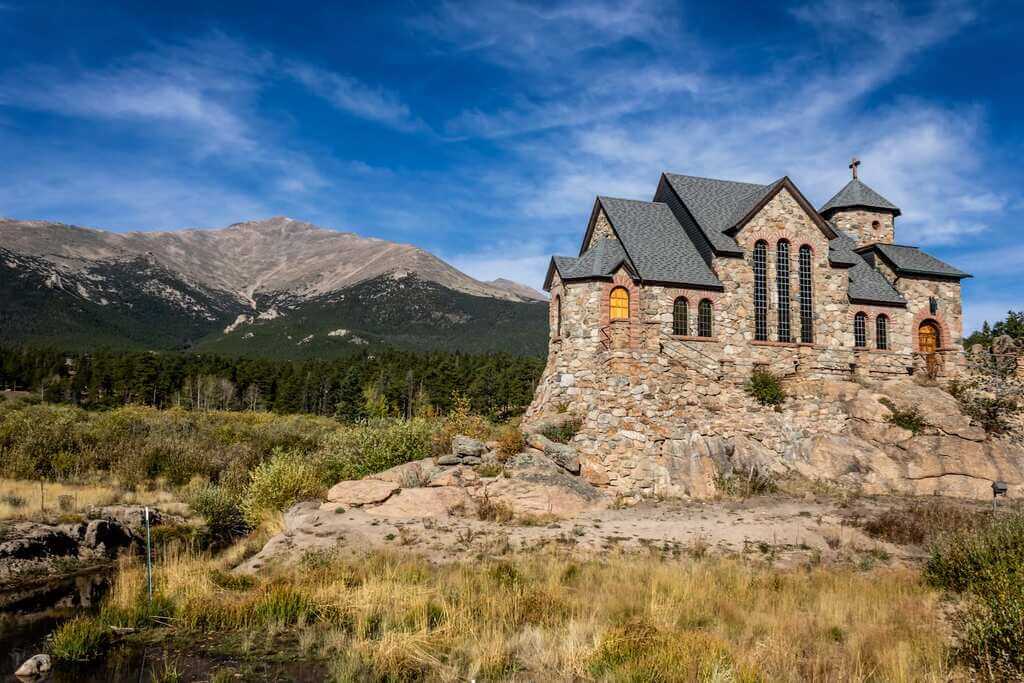
Allenspark, Colorado’s Chapel on the Rock, is a working Catholic chapel and a popular tourist destination. St. Malo Retreat, Conference, and Spiritual Center in Denver is home to a chapel dedicated to the Catholic Archdiocese of Denver.
Inspired by the Biblical phrase “upon this rock I will build my church,” Monsignor Joseph Bosetti came to discover a massive rock formation east of Rocky Mountain National Park in 1916 and envisioned a chapel constructed on the Rock. Construction was delayed by about two decades due to his financial difficulties; he also had to contend with the Colorado Highway Department over preserving the granite.
In 1936, Jacques Benedict, a Denver architect, constructed the ChapelChapel, built on land donated by Mr. and Mrs. Oscar Malo. The Chapel was designated a historic landmark by Boulder County in 1999.
Pope John Paul II blessed the Chapel during his visit to Denver for World Youth Day in 1993. Later, he went for a trek in the nearby forests and stayed at the Saint-Malo Retreat Center for a few days. After a terrible fire destroyed much of the retreat facility in November 2011, the Chapel on the Rock was the only one to remain open after the retreat center was forced to shut down. Although it wiped off most surrounding lands, the Chapel on the Rock survived the September 2013 floods.
12. Cadet Chapel (Air Force Academy, Colorado, USA)
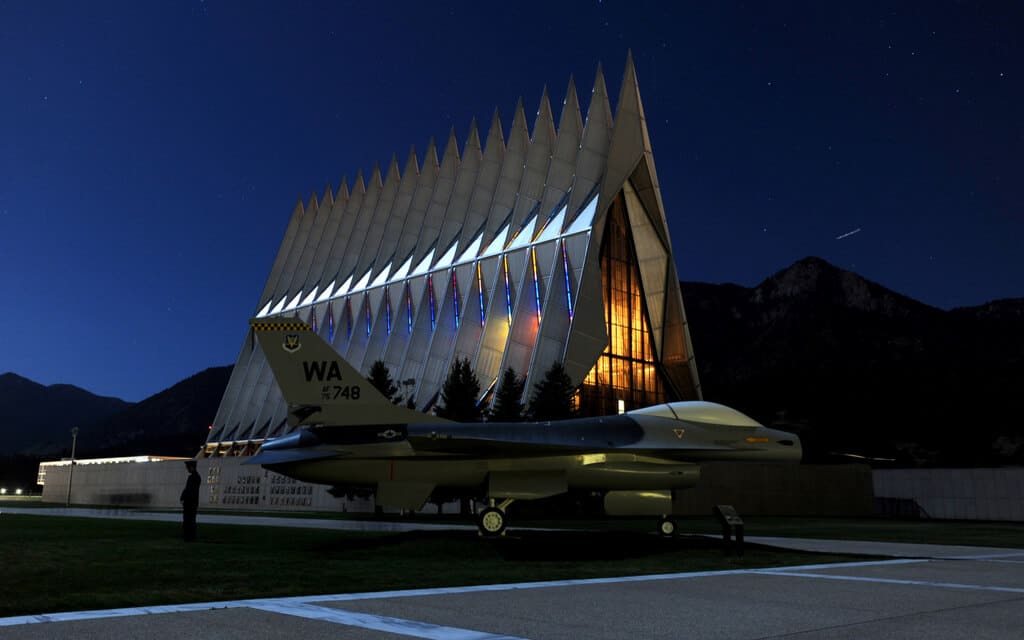
The distinctive feature of the Cadet Area at the United States Air Force Academy north of Colorado Springs in the United States Air Force Academy Cadet Chapel, which was completed in 1962. Cadet Chapel, a controversial modernist structure when it was first built, has since gained acclaim as a classic.
The Cadet Chapel received the American Institute of Architects’ National Twenty-five Year Award in 1996 and was designated a U.S. National Historic Landmark in 2004 as part of the Cadet Area. The Chapel’s row of seventeen spires is its most eye-catching feature. Due to budget constraints, the original design called for twenty-one spires.
The structure is a five-ton tubular steel frame with aluminum panels of 100 identical 75-foot-long (23-meter) tetrahedrons. The panels were made in Missouri and delivered to the job site via rail. Gaps in the framework are filled with 1-inch-thick (25-mm) colored glass between the tetrahedrons, spaced one foot apart.
A mosaic of colored glass in an aluminum frame fills the tetrahedrons that form the spires.
While triangular aluminum panels fill the tetrahedrons that separate the spires, it’s 150 feet (46 meters) high and 280 feet (85 meters) long when it comes to Cadet Chapel itself. An aluminum handrail and steel railings capped by granite handrails lead to a one-story landing on the south side of the building. In contrast with the doors, the landing has a band of gold anodized aluminum panels designed and detailed to match the doors themselves.
13. St. Augustine Church (Brookland, Kent, UK)
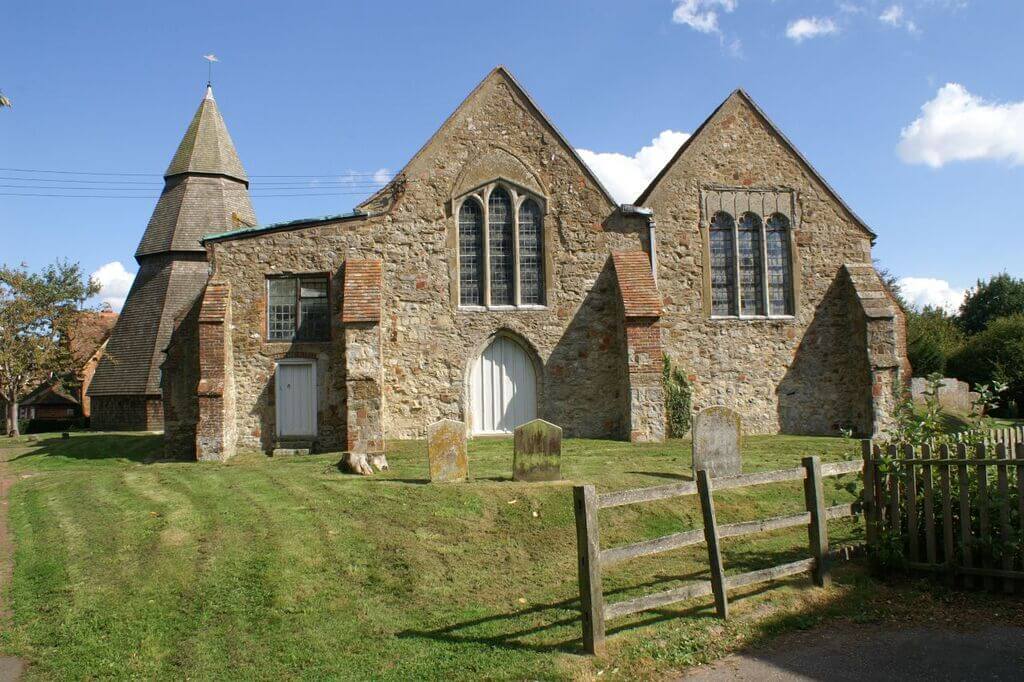
Brookland, Kent, St Augustine’s Church is a Grade I listed Anglican church near Walland Marsh, about 5 miles northeast of Rye, East Sussex. It was first constructed about the year 1250. The church’s bell tower stands apart from the rest of the structure. The bell tower is a freestanding construction located near the north porch of the church and is not part of the church itself.
Before adding the new bell cage in the 15th century, the construction had just been a square framework without any covering. In 1936 and 1990, it was reclaimed twice. The church’s interior has a south aisle that runs the length of the building and a continuous nave and chancel with no chancel arch.
The arcades include seven south-facing and six north-facing hooks but no stained-glass windows. The upper course depicts the zodiac signs, while the below system depicts each month’s agricultural work relevant to that particular year. The month is displayed in early French on an arch over each workstation. In 1973, two smaller bells were made from the metal of an enormous bell, and the set was rehung in a new frame with the original five bells. Constructed in the 14th century, the north porch is made of wood, with a clock tower situated next to it.
14. Device to Root Out Evil (Calgary, AB, Canada)

Device to Root Out Evil’ is an upside-down, New England-style church built with its steeple in the ground. It was created as a sculpture by American artist Dennis Oppenheim. Initially called ‘Church,’ it was proposed to New York City’s Public Art Fund in Church Street, where the artist lived.
However, it was considered too controversial, so they changed the name, and the sculpture was fabricated and installed as part of the 1997 Venice Biennale. Stanford University approved the purchase of the piece in 2003, but the decision was subsequently vetoed by Stanford’s president, who judged it; “inappropriate for the campus.”
It was later installed in a public park in Vancouver, Canada, as part of the Vancouver Sculpture Biennale in 2005, but again was dogged by controversy and was subsequently relocated to the Glenbow Museum in Calgary, where it was on display until 2014. It is now in the Plaza de la Puerta de Santa Catalina in Palma, Mallorca.
The 7.5m tall sculpture is fabricated from galvanized steel, perforated metal, and Venetian glass. Oppenheim said of the work, “It’s an effortless gesture that’s made here, simply turning something upside-down. One is always looking for an essential gesture in sculpture, the economy of motion: the simplest, most direct means to work. Turning something upside-down elicits a reversal of content, and pointing a steeple into the ground directs it to hell as opposed to heaven.”
Summing Up!
We hope these churches have itched your wanderlust. They’re all about a rich heritage. Churches have traditionally been regarded as among society’s most significant and spectacular structures because of their design and construction to host religious ceremonies and inspire people to worship God. This is because religious leaders erected enormous buildings with spires pointing to the skies and gigantic facades decorated with biblical themes to depict the grandeur and authority of God.
Romanesque and Gothic architecture gradually gave way to Renaissance and Baroque elements over the ages and millennia. They’ve evolved along with the glimmering artifacts and celestial works of art that adorn their chapels and sanctuaries. There are now millions of worshipers and tourists flocking to these stunning cathedrals every year, making them essential architectural and historical landmarks. You can also prepare yourself for a trip to such awe-inspiring destinations with beautiful architecture.
Find out more:-

